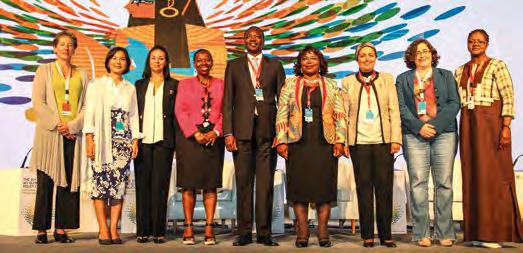
5 minute read
BARRIERS TO ACHIEVING GENDER DIVERSITY: PERSPECTIVES OF AFI MEMBER INSTITUTIONS
BARRIERS TO GENDER DIVERSITY: PERSPECTIVES OF AFI MEMBERS
This section explores the barriers that AFI members face in promoting gender diversity at the institutional level. They have been categorized into sub-sections based on an analysis of the online survey and more indepth discussions that took place during the phone interviews.
Advertisement
CHALLENGES IN MAINTAINING WORK-LIFE BALANCE
A majority of respondents perceived balancing work and family life as the primary barrier to reaching leadership positions within their institutions. This challenge exists but is not sufficiently acknowledged, is often misunderstood, and its impact extremely underestimated. This in effect results in its frequent dismissal as a significant barrier in this context. Through the phone interviews, respondents conceded that women in their institutions are usually confronted with the choice between climbing the organizational ladder to advance to higher positions or starting and caring for a family. A shortage or absence of customized remuneration, health, and family benefits further exacerbate this phenomenon. This is not different from the findings of a study on the participation and advancement of women in the workforce in Southeast Asia, which found that “societal expectations of women as primary house-makers and caregivers puts a burden on women to balance work and family priorities.” 24 These sociocultural factors, which over time have solidified social structures that preserve the gender inequalities that are intrinsic in society, must be seriously taken into account when addressing the issue of gender diversity.
WOMEN CONSIDERED TO LACK LEADERSHIP QUALITIES
Interviewees shared that women are typically not considered to possess the leadership qualities essential to progressing into leadership positions. This in turn causes women to face reduced levels of confidence and selfesteem, which discourages them from taking action to advance their careers within the bank.In institutions with a leadership that is skewed towards men, women do not get the required support and advice from their male colleagues and superiors. They are instead often perceived to be more suited to administrative roles that are concentrated at lower levels of the institutional hierarchy. The study found that five respondents thought an increase in the representation of women at the leadership level of their institutions would be perceived negatively by employees of the bank, two of the respondents being women and three of them men. According to the Central Bank of Lesotho, the reasons preventing women from advancing into leadership positions need to be assessed and addressed in spite of the provision of “equal opportunities” to employment in the bank. These include perception barriers that hinder any progress. Only three out of the nine AFI members interviewed have initiatives to promote women to reach leadership levels, which are all still in the inception phase and yet to be executed. These initiatives are mostly centered on creating awareness through leadership training and women-focused recruitment policies. In this regard, the Central Bank of Egypt appears to be a pioneer with the launch of the “Women Mentor Program” in collaboration with the National Council for Women in Egypt and the Top 50 Women Forum to create a pool of qualified women in leadership positions. Similarly, Bank of Zambia also provides leadership trainings for its female Directors. Finally, respondents stated that the slow career progression experienced by women, followed by a seemingly “dead end” at the Director’s level in the bank often induced women professionals to resign.
LOW LEVELS OF AWARENESS
Further analysis on the survey responses highlighted gaps that currently exist in the human resource capacity of member institutions. The ability to mainstream gender diversity into institutional policies, systems, and procedures requires adequate and competent human resource capacity that is aware of and thoroughly sensitized to the importance of overcoming the unconscious biases that prevent gender-sensitive hiring, and make available employment opportunities that are more just to women. When exploring the initiatives taken by the member institutions surveyed, it was found that only the Bank of Zambia provides an in-house (as opposed to in-collaboration with other partners) training program for their staff to specifically raise awareness on the issue of gender diversity. Additionally, even amongst the respondents themselves, it was manifest that the level of understanding about gender diversity varied.
While all 19 respondents seemed to be aware of the term “gender diversity,” the level of understanding largely decreased as the depth of the questions increased. The interviewees who as champions of the cause have high levels of understanding of the subject, underlined the need for trainings and toolkits to enhance the understanding of gender diversity, its rationale, and its link to gender-sensitive financial inclusion policymaking to benefit women. The Reserve Bank of Fiji stressed the need for adequate financial resources and technical capacity to promote gender diversity within members’ institutions so that employees meaningfully understand the objective and the role gender diversity plays in policymaking.
24 Women’s World Banking, 2015, “Women’s Workforce Participation and Advancement in Southeast Asia,” p. 7. Available at: http://www. womensworldbanking.org/wp-content/uploads/2016/01/WomensWorkforce-Participation-and-Advancement-in-Southeast-Asia.pdf .
LIMITED ACCESS TO MENTORSHIP AND CAPACITY BUILDING
A majority of the interviewees stressed the need to provide formal mentorship to young women professionals to build the female talent pool, which is currently limited in all the member institutions interviewed. From the phone interviews, it can be inferred that a majority of women leaders have reached their current position through their own efforts with little or no mentorship. To strengthen the talent pool, interviewees stressed the need for adequate and appropriate capacity building measures reflecting the needs and levels of expertise of employees.
The Central Bank of the Solomon Islands stated that it experienced a decrease in the number of women in leadership positions from five in 2015 to two in 2016, a trend which demotivates other women professionals from aspiring to reach leadership positions. It also underlined that limited access to role models and mentorship prevents women from reaching leadership positions, as women are less assertive and depend on recommendation for promotions, unlike men who demand for it confidently. With men (average 90% based on estimated data) dominating leadership positions in the Central Bank of the Solomon Islands, potential in female staff is either overlooked or those requiring mentorship and guidance to assume higher responsibilities are not provided these opportunities. This barrier was also highlighted in OMFIF’s recently published 2018 Gender Balance Index, which cites that an absence of role models or mentors for women in central banks prevents them from pursuing long careers in the sector. 25
25 OMFIF, 2018, “2018 Gender Balance Index Bulletin,” p. iii. Available at: https://www.omfif.org/analysis/gender-balance-index-2018 The 15th Consumer Empowerment and Market Conduct (CEMC) and 17th Financial Inclusion Data (FID) Working Group meetings in Merida, Mexico (March 2018).

AFI Joint Learning Programme on Consumer Protection: Enhanced Market Conduct Regulation and Supervision for Financial Inclusion hosted by the Central Bank of Armenia in Dilijan, Armenia (March 2018).






